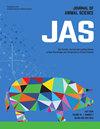Different vitamin D supplementation strategies impact serum vitamin D concentrations and the mRNA expression of genes related to vitamin D metabolism, mitochondria respiration, redox balance, and immune system in weanling piglets
IF 2.7
2区 农林科学
Q1 AGRICULTURE, DAIRY & ANIMAL SCIENCE
引用次数: 0
Abstract
This study compared the effects of different vitamin D supplementation strategies to pre- and post-weaning piglets on vitamin D metabolism and health-related parameters. Sixty Yorkshire-Landrace × Duroc suckling piglets were selected at the first day of age and randomly assigned to one of two vitamin D supplementation strategies (n = 30 pigs per treatment): CTR – oral saline at days 2, 8 and 21 of age and, from weaning (day 21), in-feed supplementation with 2000 IU of vitamin D as cholecalciferol; and VD - oral 25-hydroxycholecalciferol (25(OH)D3) solution at days 2, 8 and 21 of age plus 15-minute exposure to UVB light every second day from day 14 until day 21 and, from weaning, in-feed supplementation with 2000 IU of vitamin D as 25(OH)D3. Piglets were slaughtered (n = 10 pigs per treatment/day) at days 21 (before start in-feed experimental diets), 28 and 35 and blood and tissues samples (jejunum, liver and kidney) were collected. Body weight, concentrations of serum 25(OH)D3 and jejunum, liver, and kidney mRNA expression of genes related to vitamin D, antioxidant system, and immune defense were measured. Body weight was not affected by treatments (P ≥ 0.34). Serum 25(OH)D3 concentrations were greater for VD piglets at day 21, 28 and 35 (P < 0.01). No effect of treatment was detected (P ≥ 0.14) for mRNA expression in the jejunum mucosa. In the liver of VD piglets, mRNA expressions of genes related to the antioxidant system were lower at day 21 (NDUFB2) and at day 28 (BNIP3, GPX4, and MSRA) (P ≤ 0.10). The mRNA analysis in kidney during the overall period detected higher expression of genes related to the mitochondria oxidative phosphorylation (COX17, NDUFB2, and NDUFB6) in VD groups compared to CTR (P ≤ 0.09). The expression of CYP27B1 in kidney was higher at day 28 and CYP24A1 was lower at day 21 but higher at day 35 for VD animals. In conclusion, during the pre-weaning period, dietary 25(OH)D3 supplementation combined with UVB exposure was effective in increasing serum 25(OH)D3 concentrations at weaning whereas in the post-weaning period dietary 25(OH)D3 supplementation at 2000 IU/kg was more efficient then dietary cholecalciferol at similar levels. The overall results indicate that 2000 IU of vitamin D/kg of diet, independently of source, may be enough to improve the vitamin D status of post-weaning piglets. However, the use of dietary 25(OH)D3 may promote a better modulation of vitamin D metabolism and redox balance.求助全文
约1分钟内获得全文
求助全文
来源期刊

Journal of animal science
农林科学-奶制品与动物科学
CiteScore
4.80
自引率
12.10%
发文量
1589
审稿时长
3 months
期刊介绍:
The Journal of Animal Science (JAS) is the premier journal for animal science and serves as the leading source of new knowledge and perspective in this area. JAS publishes more than 500 fully reviewed research articles, invited reviews, technical notes, and letters to the editor each year.
Articles published in JAS encompass a broad range of research topics in animal production and fundamental aspects of genetics, nutrition, physiology, and preparation and utilization of animal products. Articles typically report research with beef cattle, companion animals, goats, horses, pigs, and sheep; however, studies involving other farm animals, aquatic and wildlife species, and laboratory animal species that address fundamental questions related to livestock and companion animal biology will be considered for publication.
 求助内容:
求助内容: 应助结果提醒方式:
应助结果提醒方式:


